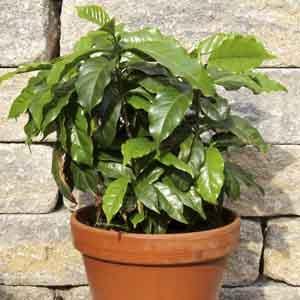Features
The Arabian coffee tree is the world’s primary source of coffee beans. This tree is native to Ethiopia but the popularity of coffee, and demand for beans, has resulted in growing operations throughout the world. Coffee trees produce big, glossy, beautiful foliage and make excellent houseplants for bright locations. Plants are not likely to bloom and produce beans when grown as a houseplant. They can also be grown in the ground or large patio planters outdoors in temperate climates.
Uses
A great potted plant for a sunny spot indoors or on a lightly shaded deck, patio, or porch during warm weather. A lovely landscape plant for warm, frost-free climates.
Plant Feed
Once every month during growing season.
Watering
Keep soil evenly moist.
Soil
All-purpose potting mix.
Basic Care Summary
Thrives in a warm location with bright, indirect light. Keep soil consistently moist. Can be pruned freely to maintain desired size.
Planting Instructions
Start with a good quality, commercial potting soil. These are usually lighter in weight than topsoil, sterile and pest-free. Many are available with a mild starter fertilizer in the mix.
Select a container with a drainage hole or be prepared to drill holes for drainage if there are none.
Prepare the container by filling with potting soil up to 2” (5cm) from the rim of the planter. Remove the plant from its pot.
Make a small hole in the soil slightly larger than the root ball either by hand or using a trowel. Insert the plant into the hole and press soil firmly around the roots and just covering the root ball. When all the plants are potted, water thoroughly to settle the soil and give plants a good start. Place plant in a reliably sunny location.
Repot every 2 years in the same container or in a container slightly larger than the diameter of the roots.
Watering Instructions
Prefers moist but well-drained soil. Check the soil moisture with your finger. If the top 2-4” (5-10cm) of soil is dry, or plants are wilted, it is time to water.
Apply water at the soil level if possible to avoid wetting the foliage. Water the entire soil area until water runs out the base of the pot. This indicates that the soil is thoroughly wet.
Fertilizing Instructions
Fertilizers are available in many forms: granulated, slow-release, liquid feeds, organic or synthetic. Determine which application method is best for the situation and select a product with a nutritional balance designed for foliage plants.
Too much fertilizer can damage plants so it’s important to follow the package directions to determine how much, and how often, to feed plants.
Slow-release fertilizers are an especially good, care-free choice for container plants. A single application can often provide plants with the proper level of nutrition all season long.
Pruning Instructions
Most container plants can be pruned freely to maintain the desired size and shape. Keeping the foliage trimmed also keeps the plants looking neat and tidy, encourages the plant to develop more side-shoots and flowers, and reduces the demand for the plant to develop a larger root system. This is important since the roots are in a confined space.
| Category: | Houseplants |
| Available Colors: | Grown for foliage |
| Bloom Time: | Grown for foliage |
| Height Range: | 1-6' (0.3-1.8m) |
| Space Range: | 2-3' (0.6-0.9m) |
| Lowest Temperature: | 40° to 80°F (4° to 27°C) |
| Plant Light: | Bright Light |
| Companion Plants: | Dracaena, Dieffenbachia, Aglaonema |
| USDA Zone: | 10-11 |

